Day 1 of a three day Winter Tour today, and we made our way down to the Norfolk Broads. It was a rather grey start and end to the day, with a little bit of brightness in between, but dry and mild with light winds. A nice day to be out.
As we drove along the top road out of Ludham, we could already see lots of swans out on the fields on the old airfield below. We drove round on the maze of minor roads to a convenient spot overlooking where they were feeding. They were split at first into two groups, one feeding in the remains of a harvested sugar beet field and the other group loafing in a neighbouring field of winter wheat. Through the scope, we could see there was a mixture of smaller Bewick’s Swans and larger Whooper Swans.

The feeding swans started to fly across in small groups to join the bigger herd in the winter wheat, where many were asleep in a slight dip in the ground. We could count around 100 swans in total, but it was hard to work out how many of each species there were today.
It was good to see the two species side by side, to be able to compare them. As well as being larger, the Whooper Swans have a distinctive wedge of yellow on their bills extending further towards the tip, whereas the yellow on the Bewick’s Swans is blunt, squared off, and not as extensive.
A pair of Stock Doves were feeding in the ploughed field in front of us and one of them did a nice fly round, showing off the black trailing edge to the wing, lacking the white band of a Woodpigeon. A couple of Common Buzzards were flying round, and we watched one fly off with a Brown Rat, the latters tail trailing from its talons. We would be looking for geese today too, and several groups of Pink-footed Geese flew over calling while we were watching the swans, to start things off.
Gradually, the swans started to walk back into the sugar beet field to feed, and we decided to move on. As we drove further into the Broads, we noticed three tall grey shapes in a field so we stopped for a look, flushing several Fieldfares from the hedge as we pulled up. As we suspected, the tall birds in the field were Common Cranes, a family party, two adults with their fully grown juvenile from last year, the young one browner and lacking the contrasting black-and-white head pattern of the adults.
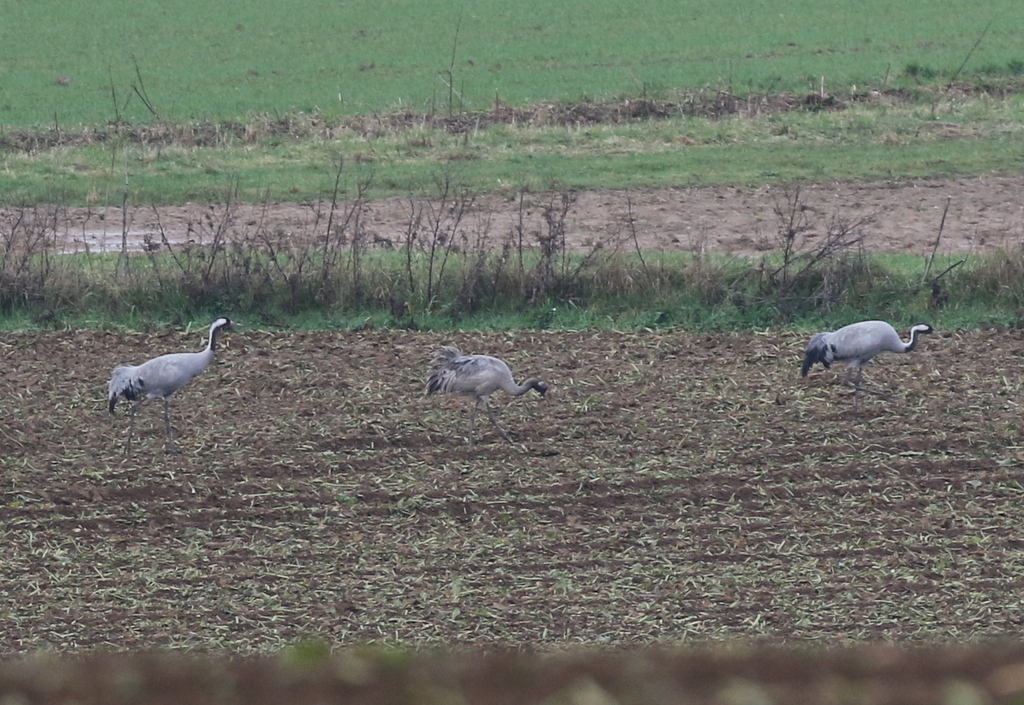
As we watched the family of Cranes feeding, like the swans we had seen earlier in a recently harvested sugar beet field, another pair of Cranes flew over. They disappeared down behind some trees further back and we thought they had most likely landed out of view, but when we looked further round we noticed two Cranes in another field, on the edge of a maize strip. Were they the same ones we had just seen flying over? But every time we looked back over, more Cranes appeared from out of the maize until there were seven together on that side, making ten visible in total including the first family of three. There could easily have still been more in the maize!
We had turned our attention back to the original family when we heard Cranes ‘bugling’. We looked across to see one of the pairs on the edge of the maize strip displaying. They were walking together, side by side, with the heads up and their bustles raised as they called. It was clearly a bit of a dispute, as they took off and flew towards one of the other Cranes standing in the field. The larger of the pair, the male, swooped down at the standing bird and chased it a short distance across the field. The pair then strutted together for a minute or so before flying off.
There was a cover strip, planted with a wild bird seed mix, along the edge of the road where we had pulled over. Birds were constantly flying back and forth across the road between the strip and the hedge of a garden the other side. They were mostly Greenfinches, always good to see in numbers given how the species had declined in recent years, along with quite a few House Sparrows, a smaller number of Chaffinches and Goldfinches, and one or two Reed Buntings.
Further over, a tight flock of Linnets kept flying up out of the cover strip, flying round and dropping back in again, rather than flying over to the garden. We watched their distinctive bouncing flight, looking almost like they were held up with elastic!
Taiga Bean Goose is one of the key target birds to see down in the Broads at this time of year. Since the start of 2018, it has been treated as a separate species from Tundra Bean Goose in the UK (the two were previously lumped together as ‘Bean Goose’). The Yare Valley is one of only two traditional wintering sites in the UK for this now species. The wintering population here is declining and a maximum of just over 20 have been seen in the last few years, so they can be tricky to find.
The Taiga Bean Geese had been reported from Cantley Marshes this morning, so we made our way over there nest. As we pulled up next to yet another recently harvested sugar beet field (we are in the shadow of the Cantley sugar beet processing factory here, after all!), a large flock of Rooks were looking for invertebrates among the chopped up leaves and debris.

We made our way down over the railway crossing and stopped to scan the grazing marshes. At first sight, it looked quite devoid of life. A Peregrine was perched on a distant gatepost out in the middle and a Marsh Harrier was visible in the reeds beyond. A couple of Chinese Water Deer were hiding in the grass. The marshes here are often full of geese of various species, but we couldn’t see any at first today. We eventually found just one, lone Pink-footed Goose.
If the Taiga Bean Geese are not here, they can often be on the neighbouring marshes at Buckenham. We could see some geese flying up periodically over in that direction, so we decided to head over there next. As we walked back up the hill, a small skein of Pink-footed Geese flew in over the village and disappeared over that way.
The marshes at Cantley have lots of long grass and wet ditches where it easy to hide a small group of geese, so we walked out along the footpath across the field at the top of the hill to have one more scan from higher ground. There were the Taiga Bean Geese! They were tucked down behind a couple of gates, which explained why we couldn’t see them from lower down.
Slowly, some of the Taiga Bean Geese came out from behind the gate. We could see their long bills, though variable in pattern, mostly had quite an extensive amount of orange showing.
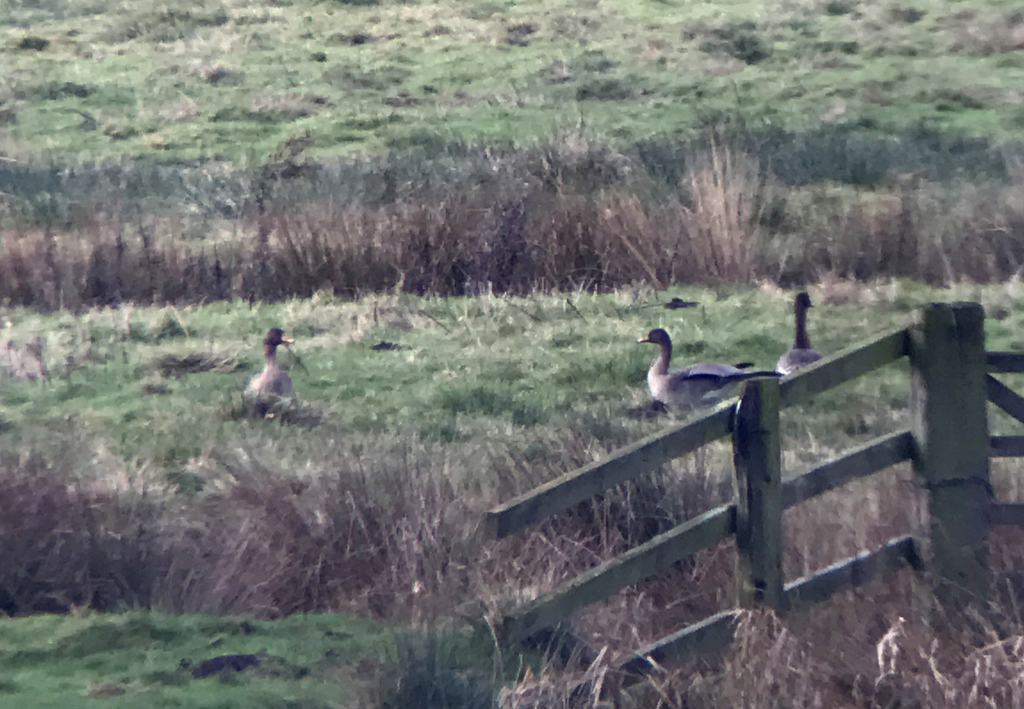
The Rooks had moved on, but there were now at least twenty Pied Wagtails feeding in the beet field, and a single Meadow Pipit was with them. Looking down at the near edge of the marshes, we could see two Marsh Harrier, a female chasing a darker juvenile. There was still an hour or so before lunch so, despite the fact we had seen the Taiga Bean Geese already, we decided to call in at Buckenham to see what else we could see on the marshes there.
A large flock of Wigeon were feeding out on the marshes as we walked down the track towards the river. We could hear their distinctive whistles. Some of them were very close to the track, so we could get a great look at them, the drakes with their distinctive rusty heads and creamy yellow paint stripe up their foreheads. When something spooked them, they all flew up and dropped into the nearby ditch, where a pair of Teal and several Shoveler were already feeding.
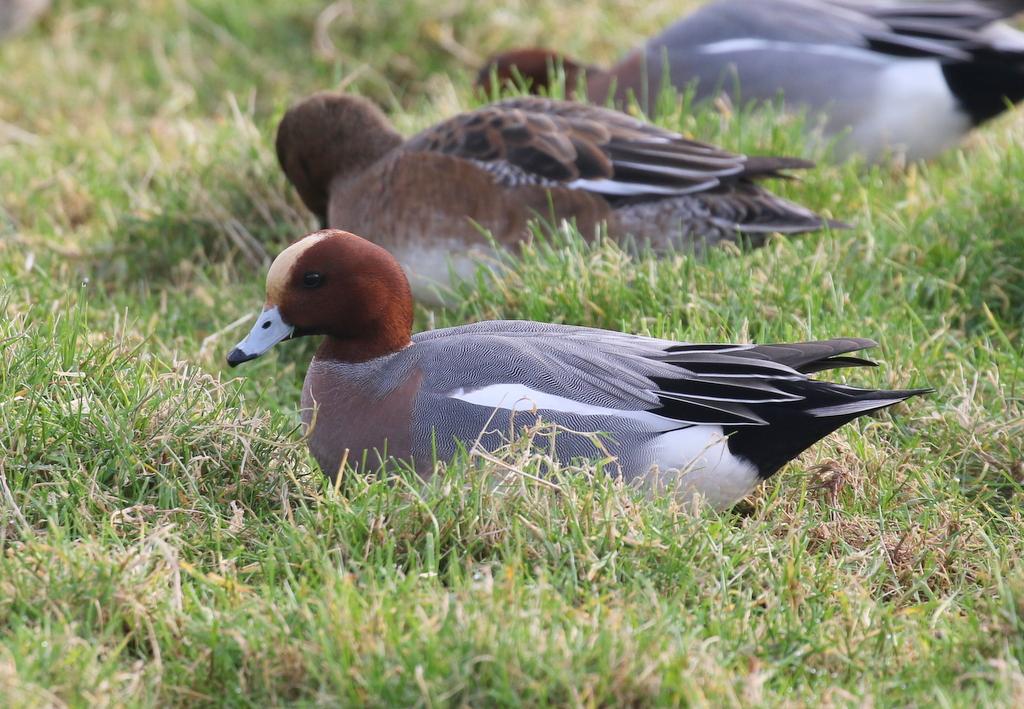
There were a few more geese on the marshes at Buckenham today, mostly Canada Geese and Greylags, but with a small number of feral Barnacle Geese in with them. Another group of about thirty geese flew up from the back of marshes, and dropped straight back down into the grass. Through the grass we could see they were Russian White-fronted Geese, with a narrow white surround to the base of the bill from which they get their name, as well as distinctive black belly barring.
A liberal scattering of Lapwings was spread out across the shorter grass. In with them, we found eight Ruff, including one with a white head (white-headed males make up a small percentage of the population), though they were walking round quickly and hard to keep up with. We heard a Water Pipit call once briefly, but we couldn’t see where the sound came from and there was no sound of it around the pools in the grass. We did find a Little Egret and a Grey Heron out there though.
Continuing on along the track, we stopped to scan the larger pools at the far end. There were lots more Teal asleep on the edges, and more Shoveler along with two Shelduck. A single Lesser Black-backed Gull was standing in the far corner and when we got the scope on it we could see a couple of Common Snipe lurking on the muddy bank next to it.
It was lunchtime now, so we walked back to the car, stopping briefly to watch a Red Kite circling over the trees beyond. We drove round to Strumpshaw Fen for lunch. The Reception Hide pool held lots of ducks as usual, with Gadwall an addition to the day’s list, as well as more Shoveler and Mallard. The resident Black Swan was standing on the edge of the water with one of the Mute Swans.

While we ate, we kept an eye on the feeders nearby. A steady succession of Blue Tits and Great Tits kept darting in to grab sunflower seeds. We could hear a Marsh Tit calling in the trees, but it was some time before it eventually came in to the feeders. Then we got good views of it, as rather than just darting in and out as it sometimes does, it perched on a dead tree stump next to the feeders several times and waited its turn.
There were a few other birds in the trees around Reception Hide. A Lesser Redpoll appeared in the tops with a Goldfinch before flying off back towards the wood. A Bullfinch came out of the trees calling and disappeared off towards the car park. A Siskin flew over the pool calling.
As we were packing up, we heard a Great Spotted Woodpecker drumming. With a few birds singing too today, it almost felt like spring was on its way already! As we walked back to the car across the railway, another Great Spotted Woodpecker responded, drumming from across the road.
A small group of Tundra Bean Geese had been reported for the last few days feeding in fields near Thrigby. So, as we made our way back north, we diverted round to look for them. We found them easily enough, in exactly the field they were in yesterday. They were on their own in some winter wheat, and mostly sat down, loafing. From the layby where we could pull over, they had typically chosen a spot just over the top of the ridge where they were mostly out of view.
At first, we could just see one of the Tundra Bean Geese which had stood up, but as the others began to move we could see more of them. Through the scope, we could see their bills, which were very different from the Taiga Bean Geese we had seen earlier – shorter and deeper-based, with a more restricted band of orange just behind the dark tip.
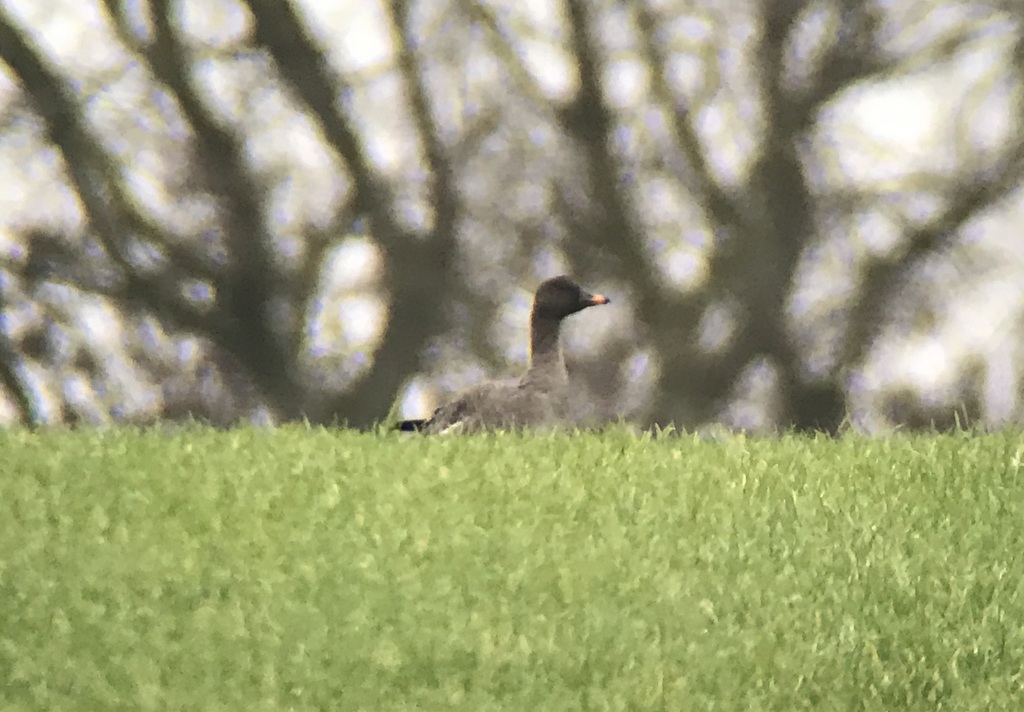
There were no other geese with them, though there was a small herd of Mute Swans feeding in a field of oil seed rape on the other side of road and four Egyptian Geese away in the distance. Several Common Snipe flew up from time to time out of the oil seed rape too, but instantly disappeared again as soon as they landed. A Chinese Water Deer was lying down out there too and a Common Buzzard perched up in a tree at the back.
We made our way over to Stubb Mill to end the day. The cloud had thickened again and the light was already starting to go when we arrived. We were helpfully directed straight away to a Merlin perched on a post at the back of the fields. It was remarkably hard to see, being very similar in colour to the top of the post. A Green Woodpecker flew across over the grass and a Stonechat flicked up briefly.
There is a flight pond out in the fields beyond the mill. As we arrived, the landowner was just going out on his quadbike to put feed out for the ducks. It wasn’t long after he left again, that a pair of Cranes flew up from where they had been lurking behind the reeds and landed over by the pond, presumably to help themselves to some of the food. We could just see them walking about through the scope. A flock of Shelduck flew in too.
The Marsh Harriers were already gathering in the reeds further over. As we scanned across, we could see several perched in the scattered bushes. From time to time, more would fly up and we counted at least twenty at in the air together at one point. There was a slow trickle of Marsh Harriers still arriving, flying in from various directions, but it felt like a lot were probably already down in the roost this evening.
It was time for the Cranes to head into roost now. First one flew across, over the trees at the back, followed by another which came through much lower over the reeds. Then another three Cranes flew in, much closer this time, silhouetted against the last of the light.
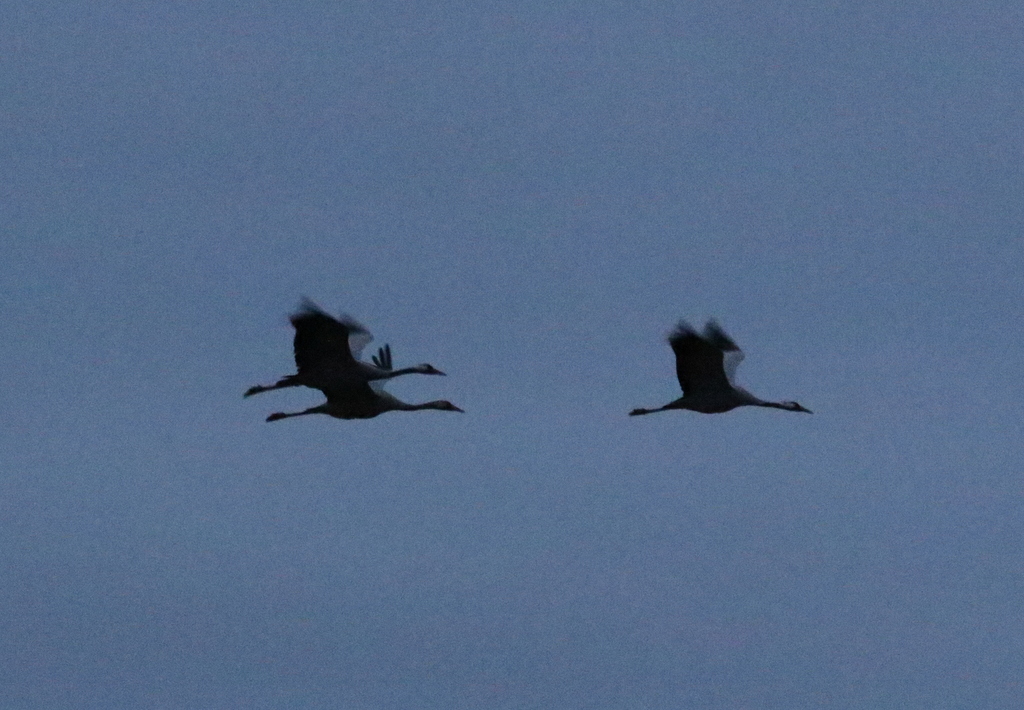
As it started to get dark, a herd of Red Deer emerged from the reeds and walked out across the marshes. A Woodcock shot past just a few feet from us, right in front of the viewpoint, but was gone as quickly as it appeared. It was time to head home, and as we got back to the car we could hear the Pink-footed Geese calling, going in to roost.
















